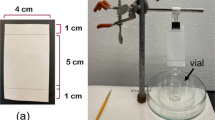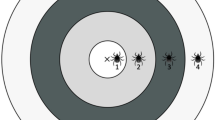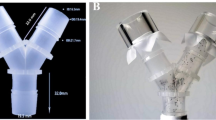Abstract
In our search for tick repellents of plant origin, to be used as alternatives to commercial arthropod repellents, we investigated the effect of the well known plant signaling compound methyl jasmonate (MJ) using nymphs of the tick Ixodes ricinus. In laboratory tests, pieces of cloth with MJ at 0.075, 0.15, 0.30 and 0.75 mg/cm2 yielded increasing repellencies against the nymphs: 57%, 71%, 92% and 99%, respectively, of the nymphs did not cling to the cloth. Repellency of MJ was also investigated in a tick-infested woodland area in central Sweden. Cotton flannel cloths sprayed with 0.05, 0.1 or 0.2 mg/cm2 MJ dissolved in acetone were dragged over the ground vegetation. The numbers of nymphs on the treated cloths were significantly lower than those on the untreated cloth. Thus, MJ has, at the concentrations tested, significant repellent activity against I. ricinus nymphs.



Similar content being viewed by others
References
Arnason JT, Philogene BJR, Donsko N, Kubo I (1987) Limonoids from the Meliaceae and Rutaceae reduce feeding growth and development of Ostrinia nubilalis. Entomol Exp Appl 43:221–226
Barnard DR (2000) Repellents and toxicants for personal protection. WHO/CDS/WHOPES/GCDPP/2000.5. 48 pp
Berger S (2002) Jasmonate-related mutants of Arabidopsis as tools for studying stress signaling. Planta 214:497–504
Birkett MA, Campbell CA, Chamberlain K, Guerrieri E, Hick AJ, Martin JL, Matthes M, Napier JA, Pettersson J, Pickett JA, Poppy GM, Pow EM, Pye BJ, Smart LE, Wadhams GH, Wadhams LJ, Woodcock CM (2000) New roles for cis-jasmone as an insect semiochemical and in plant defense. Proc Natl Acad Sci USA 97:9329–9334
Boughton AJ, Hoover K, Felton GW (2005) Methyl jasmonate application induces increased densities of glandular trichomes on tomato, Lycopersicon esculentum. J Chem Ecol 31:2211–2216
Bruin J, Dicke M (2001) Chemical information transfer between wounded and unwounded plants: backing up the future. Biochem Syst Ecol 29:1103–1113
Creelman RA, Tierney ML, Mullet JE (1992) Jasmonic acid/methyl jasmonate accumulate in wounded soybean hypocotyls and modulate wound gene expression. Proc Natl Acad Sci USA 89:4938–4941
Daniel M, Kolar J, Zeman P, Pavelka K, Sadlo J (1998) Predictive map of Ixodes ricinus high-incidence habitats and a tick-borne encephalitis risk assessment using satellite data. Exp Appl Acarol 22:417–433
De Boer JG, Dicke M (2004) The role of methyl salicylate in prey searching behavior of the predatory mite Phytoseiulus persimilis. J Chem Ecol 30:255–271
Estrada-Peña A (1999) Geostatistics as predictive tools to estimate Ixodes ricinus (Acari: Ixodidae) habitat suitability in the Western Palearctic from AVHRR satellite imagery. Exp Appl Acarol 23:337–349
Franceschi VR, Krekling T, Christiansen E (2002) Application of methyl jasmonate on Picea abies (Pinaceae) stems induces defense-related responses in phloem and xylem. Amer J Bot 89:578–586
George JE, Pound JM, Davey RB (2004) Chemical control of ticks on cattle and the resistance of these parasites to acaricides. Parasitology 129(Suppl):S353–S366
Graf JF, Gogolewski R, Leach-Bing N, Sabatini GA, Molento MB, Bordin EL, Arantes GJ (2004) Tick control: an industry point of view. Parasitology 129(Suppl):S427–S442
Ibrahim MA, Nissinen A, Holopainen JK (2005) Response of Plutella xylostella and its parasitoid Cotesia plutellae to volatile compounds. J Chem Ecol 31:1969–1984
James DG (2005) Further field evaluation of synthetic herbivore-induced plant volatiles as attractants for beneficial insects. J Chem Ecol 31:481–495
Koul O, Dhaliwal GS (eds) (2001) Phytochemical biopesticides. Harwood Academic Publishers, Amsterdam, The Netherlands
Nolan J (1990) Acaricide resistance in single and multi-host ticks and strategies for control. Parassitologia 32:145–153
Sharma VP, Ansari MA (1994) Personal protection from mosquitoes (Diptera: Culicidae) by burning neem oil in kerosene. J Med Entomol 31:105–107
Slesak E, Slesak M, Gabrys B (2001) Effect of methyl jasmonate on hydroxamic acid content, protease activity, and bird cherry-oat aphid Rhopalosiphum padi (L.). probing. behavior. J Chem Ecol 27:2529–2543
Vick BA, Zimmerman DC (1984) Biosynthesis of jasmonic acid by several plant species. Plant Physiol 75:458–461
Acknowledgments
We are grateful to The Swedish International Development Co-operation Agency (Sida/SAREC) and the Swedish Research Council for Environment, Agricultural Sciences and Spatial Planning (Formas/SJFR) for funding this work.
Author information
Authors and Affiliations
Corresponding author
Rights and permissions
About this article
Cite this article
Garboui, S.S., Jaenson, T.G.T., Borg-Karlson, AK. et al. Repellency of methyl jasmonate to Ixodes ricinus nymphs (Acari: Ixodidae). Exp Appl Acarol 42, 209–215 (2007). https://doi.org/10.1007/s10493-007-9066-1
Received:
Accepted:
Published:
Issue Date:
DOI: https://doi.org/10.1007/s10493-007-9066-1




